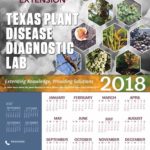 Fusarium Ear Rot
Fusarium Ear Rot
SCIENTIFIC NAME of causal agent(s): Fusarium verticillioides, Fusarium proliferatum, Fusarium subglutanins
DISEASE DESCRIPTION
SYMPTOMS:
Fusarium-affected kernels are isolated or in patches on the ear. Diseased kernels appear brown and typically there is pink mold on the ears. Also, sometimes Infected kernels may have the “starburst” symptom, which is light-colored streaks radiating from top of kernels where silks were attached.
BIOLOGY:
Fusarium ear rot caused by Fusarium fungi that survive on residue of corn and other plants, especially grasses. Disease can occur under a wide range of environmental conditions but is more severe when weather is warm and dry. Pathogen enters ear primarily through wounds such as bird and insect damage. When these agents occur to ears, infection will increase. Rots are reduced in ears that mature hanging downward. When infection is prevalent, yield, quality, and feed value can be reduced. More importantly, fumonisins are a group of toxic chemicals called mycotoxins produced by Fusarium fungi in the corn belt. They cause serious disease and may even be fatal to animals, including livestock, and humans.
MANAGEMENT METHODS:
To control Fusarium ear rot, several strategies can be carry out including:
- Planting resistant hybrids;
- Rotating out of corn for at least a year;
- Burying or breaking down crop residue before tillage;
- Using insecticide to prevent wounds caused by insets;
- Harvesting early and storing in a dry condition (below 15% moisture).
RESOURCE LINKS:
For symptoms, biology and management methods referring:
https://plantdiseasehandbook.tamu.edu/food-crops/cereal-crops/corn/
For disease name, pathogen, biology and management methods referring:
For pathogen and symptoms referring:
https://extension.purdue.edu/extmedia/BP/BP-86-W.pdf
This factsheet is authored by Bin Long (PhD student)

Dr. Appel’s 2017 Fall PLPA601 students
Factsheet information for the plant health issues represented by the images on the 2018 TPDDL calendar were written by graduate students enrolled in the Department of Plant Pathology & Microbiology PLPA601 Introductory Plant Pathology course in the 2017 Fall semester (course instructor: Dr. David Appel). This exercise provides an opportunity for a high impact learning activity where the students are tasked with producing an informational output directed to the general public and to provide opportunity for the students to write.

CLICK HERE to return to 2018 TPDDL Calendar page